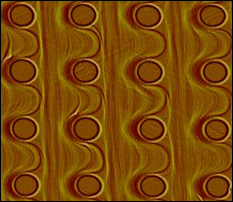Press Release
"Nature-Made" Computers
Clark School Engineers Teach Nature to "Grow" High-Tech Components
FOR IMMEDIATE RELEASE October 30, 2007
CONTACT:
Faye Levine
301 405 0379
flevine@umd.edu

Hi-res version. You can also see a video of a computer simulation of template formation (Quicktime; 40MB).
COLLEGE PARK, Md.—Computers don't grow on trees, but with a little prodding from engineers, nature can produce computer components.
At the University of Maryland's A. James Clark School of Engineering, Ray Phaneuf, associate professor of materials science and engineering, has developed a template nature can follow to produce "self-assembling" structures. The template causes atoms to be arranged in a defined pattern that can serve a variety of purposes—a semiconductor in a laptop, a component in a cell phone or a sensor in a wearable device.
The idea of self-assembly in nature has long been known—crystallization is one such process; the formation of shells into spirals is another. However, researchers have been limited to the designs that nature already knows how to make. Phaneuf's work introduces a man-made template that nature then follows, addressing a number of manufacturing difficulties.
"While we understand how to make working nanoscale devices, making things out of a countable number of atoms takes a long time," Phaneuf said. "Industry needs to be able to mass-produce them on a practical time scale."
The template process can be used by device manufacturers to mass-produce tiny components rapidly and efficiently, reduce costs, shrink device sizes, and improve devices' functionality in ways previously not possible.
"The same template can be used thousands of times," Phaneuf said. "This results in enormous savings."
Phaneuf says his work is one step in a "cocktail" approach to computer assembly—an engineer's dream in which one could "mix-up" a computer the same way one mixes a drink.
"Imagine you shake up a cocktail and spill it onto a table," Phaneuf said. "The liquid will collect in pools in a manner designated by nature.
"Now imagine that first you coated the table with wax and scraped a pattern into it. Now when you spill the liquid onto the table, it collects in the pattern you scraped into the wax—it assumes the form you want it to take. When we apply this idea to manufacturing nanoscale computer components, collections of atoms become ordered, accessible, controllable and reproducible—characteristics crucial to their use in high-tech devices."
These devices could include those used in the growing field of quantum computing, which is believed to hold promise for carrying out exceptionally difficult mathematical processes, Phaneuf said. An application of the templates might be self-assembly of coupled quantum dots to form "qubits," the building blocks of quantum computers. According to Phaneuf, templating could be used to make the manufacture of this highly complicated system more feasible: "Addressing individual qubits might be done optically, to get around the problem of trying to wire them all up."
Phaneuf's work focuses on silicon and gallium arsenide components. Silicon is the prevalent material for components in computers while gallium arsenide is used more often in cell phones.
The templates are created using photolithography (a process akin to photography, in which the template is chemically developed after being exposed to light) and etching, or by "nanoscraping," in which an atomic force microscope is used to selectively scrape the pattern into the template.
More Information: "Templating for Directed Self Assembly"
Ray Phaneuf's Research Group:
http://www.glue.umd.edu/~phaneuf/Welcome.html
Glossary:
atomic force microscope: this type of microscope can provide pictures of atoms by scanning an item with a very sharp probe in a manner similar to how a record-player needle scans a record.
gallium arsenide: a compound of gallium (Ga) and arsenic (As) that is used in semiconductors, diodes and integrated circuits; chemical formula = GaAs.
nanoscale: used to describe substances measured at the scale of a billionth of a meter.
photolithography: the transfer of an image from one surface to another using a process similar to photography (chemically developing the image after exposure to light).
quantum computing: computing based on quantum mechanics (the study of the relationship between physics and matter). Quantum computers can perform many computations simultaneously.
qubit: short for quantum bit; a single unit of information in quantum computing (analagous to a bit in conventional computing)
self-assembly: process in which the elements of a substance organize to create that substance on their own, without external stimuli (example: crystal formation). <
template: a topographical pattern that guides or directs the assembly or organization of a structure.
About the A. James Clark School of Engineering
The University of Maryland’s A. James Clark School of Engineering is a premier program, ranked among the top 20 in the world. Located just a few miles from Washington, D.C., the Clark School is at the center of a constellation of high-tech companies and federal laboratories, offering students and faculty access to unique professional opportunities.
Our broad spectrum of academic programs, including the world’s only accredited undergraduate fire protection engineering program, is complemented by a vibrant entrepreneurial ecosystem, early hands-on educational experiences, and participation in national and international competitions.
The Clark School is leading research advancements in aerospace, bioengineering, robotics, nanotechnology, disaster resilience, energy and sustainability, and cybersecurity. From the universal product code to satellite radio, SMS text messaging to the implantable insulin pump, our students, faculty, and alumni are engineering life-changing innovations for millions. Learn more at www.eng.umd.edu.